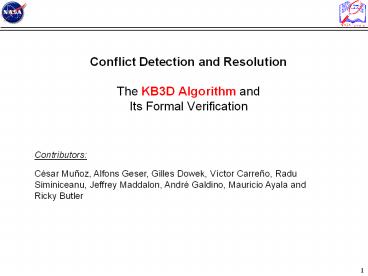Conflict Detection and Resolution - PowerPoint PPT Presentation
Title:
Conflict Detection and Resolution
Description:
Current safety assurance methods are inadequate for free flight concepts. Current method is based on human-factors oriented experimentation with high ... – PowerPoint PPT presentation
Number of Views:47
Avg rating:3.0/5.0
Title: Conflict Detection and Resolution
1
- Conflict Detection and Resolution
- The KB3D Algorithm and
- Its Formal Verification
Contributors César Muñoz, Alfons Geser, Gilles
Dowek, Víctor Carreño, Radu Siminiceanu, Jeffrey
Maddalon, André Galdino, Mauricio Ayala and Ricky
Butler
2
Conflict Detection and Resolution KB3D
Today the primary responsibility for aircraft
separation is borne by the air traffic controller.
D
.
intruder
vo
vi
vo
ownship
- Current safety assurance methods are inadequate
for free flight concepts - Current method is based on human-factors oriented
experimentation with high fidelity simulations. - But as software takes on more and more
responsibility for detecting potential conflicts
and recommending or executing the evasive
maneuvers, we will need additional methods to
guarantee safety of software. - The correctness of the algorithm must be
established for all possible situations. - Simulation and testing cannot accomplish this.
3
KB3D Conflict Detection Algorithm
- A generalization of Karl Bilimorias CDR
algorithm (used in FACET) to 3 dimensions - The KB3D algorithm produces multiple solutions
that only require a change in only one state
parameter (i.e. heading, ground speed, vertical
speed) - Formally proved that it will always generate a
valid solution for two aircraft with arbitrary
trajectories. - Completed formal proof of optimal return paths
(RR3D) - Formally proved to be coordinated
4
Axes Translation To Facilitate Analysis
Position and velocity translation of axes s
(sx, sy, sz) s0 - si v (vx, vy, vz)
v0 - vi Of course, one must translate results
back to original axes in implementation code
(easy to do).
5
KB3D Horizontal/Vertical Views
D
H
6
Resolution Maneuvers
- The KB3D algorithm generates maneuvers where only
one of vertical speed, ground speed, or heading
are changed. - (Easier for Pilot to Fly)
- Let vo' (v'ox, v'oy, v'oz ) be the resolution
velocity vector for the own - Let vo (vox, voy, voz ) be its original
velocity vector - Vertical Speed Only v'ox vox ,
v'oy voy - Ground Speed Only v'ox k vox , v'oy
k voy, v'oz v'oz - Heading Only v'ox2 v'oy2
vox2 voy2, v'oz v'oz
7
Cd3d Example
8
The Vertical Solutions
- IF not horizontally separated THEN
ELSE IF sz H
ELSE
9
Resolution and Recovery (RR3D)
- The RR3D algorithm computes
- relative escape velocity vector v' v'0 - vi
- turn time t'
- relative recovery velocity vector v'' v''0 -
vi
10
Verification Goal
- Must show
- escape maneuver (ve) maintains separation
- recovery maneuver (vr) maintains separation
- escape and recovery maneuvers reach the same
ending point at the same time as the original
course. - Turn time less than destination time 0 lt te lt tr
m solution RR3D_alg_correct THEOREM
FORALL mmember?(m,
RR3D_alg(s,vo,vi,tr)) IMPLIES
separation?(s, mve)
AND
separation?(s mte mve, mvr) AND
s tr v
s mte mve (tr - mte) mvr AND
0 lt mte
AND mte lt tr
11
Typical Correctness Theorem
llhd_escape_C THEOREM sq(sx) sq(sy)
gt sq(D) AND TEST CONDITION
sq(vox) sq(voy) / sq(vix) sq(viy) AND
TEST CONDITION hor_speed_gt_0?(ve) AND
TEST AFTER COMPUTATION
discr(1 sq(alpha), vix alpha viy,
TEST CONDITION sq(vix) sq(viy)
- sq(vox) - sq(voy)) gt 0 AND alpha IF
sq(D) sq(sx) THEN -(sq(D) - sq(sy))/(2sxsy
) ELSE (-sxsyepsDsqrt(sq(sx)
sq(sy)-sq(D)))/(sq(D)-sq(sx))
ENDIF AND (vex x1(1sq(alpha),
COMPUTED VALUE
vixalphaviy,
sq(vix)sq(viy)-sq(vox)-sq(voy)) OR
vex x2(1sq(alpha),
vixalphaviy,
sq(vix)sq(viy)-sq(vox)-sq(voy))) AND
vey alphavex
COMPUTED VALUE IMPLIES
separation?(s,ve)
12
Verification that Algorithm is Coordinated
Dont Want
- For two aircraft executing the CDR algorithm,
prove - Recommended/executed trajectories are always in
opposite directions - In a perfectly symmetric case, there is a
symmetry breaking mechanism
13
N Aircraft Collaborative Properties
- For N aircraft executing the CDR algorithm,
PROVE all recommended/executed trajectories
maintain separation
Our CDR algorithms do not need explicit
handshake to achieve coordinated resolutions.
The only information exchanged is position, and
velocity via ADS-B.
14
Status Of Formal Verifications
- KB3D formally verified for two aircraft
- RR3D formally verified for two aircraft
- KB3D formally verified to be coordinated
- KB3D vertical maneuvers formally verified to be
collaborative (for N aircraft assuming adequate
airspace above)
- Current work
- Adding ability to recover from loss of separation
- Adding target altitude intent information
- Integrating with prediction bands
- Extending analysis to cover input inaccuracies
and errors
15
How Do You Model the Pilot (N Aircraft Problem)?
- How long will he wait to execute algorithm?
- How long would he wait to turn back to course?
- How long after a conflict warning disappears
would the pilot no longer seek to resolve? - In a situation where there are multiple aircraft,
which aircraft would he chose to resolve with? - The closest aircraft?
- The one requiring the smallest heading change?
- The first one to be in conflict with
- The one with the shortest time until loss of
separation?
16
Long Term Goals
- Generalize formal proof to multiple aircraft.
- Will require a premise that involves some kind of
traffic complexity/density metric - Integration with strategic algorithms (e.g. based
on genetic algorithms) - Add aircraft performance to KB3D
- Transform KB3D to a great-circle implementation































